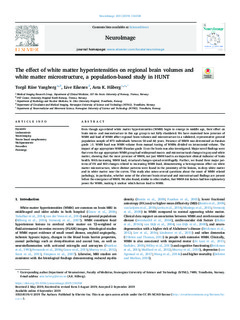| dc.contributor.author | Vangberg, Torgil Riise | |
| dc.contributor.author | Eikenes, Live | |
| dc.contributor.author | Håberg, Asta | |
| dc.date.accessioned | 2019-10-07T06:34:18Z | |
| dc.date.available | 2019-10-07T06:34:18Z | |
| dc.date.created | 2019-10-05T15:39:14Z | |
| dc.date.issued | 2019 | |
| dc.identifier.citation | NeuroImage. 2019, 203 (116158), . | nb_NO |
| dc.identifier.issn | 1053-8119 | |
| dc.identifier.uri | http://hdl.handle.net/11250/2620481 | |
| dc.description.abstract | Even though age-related white matter hyperintensities (WMH) begin to emerge in middle age, their effect on brain micro- and macrostructure in this age group is not fully elucidated. We have examined how presence of WMH and load of WMH affect regional brain volumes and microstructure in a validated, representative general population sample of 873 individuals between 50 and 66 years. Presence of WMH was determined as Fazakas grade ≥1. WMH load was WMH volume from manual tracing of WMHs divided on intracranial volume. The impact of age appropriate WMH (Fazakas grade 1) on the brain was also investigated. Major novel findings were that even the age appropriate WMH group had widespread macro- and microstructural changes in gray and white matter, showing that the mere presence of WMH, not just WMH load is an important clinical indicator of brain health. With increasing WMH load, structural changes spread centrifugally. Further, we found three major patterns of FA and MD changes related to increasing WMH load, demonstrating a heterogeneous effect on white matter microstructure, where distinct patterns were found in the proximity of the lesions, in deep white matter and in white matter near the cortex. This study also raises several questions about the onset of WMH related pathology, in particular, whether some of the aberrant brain structural and microstructural findings are present before the emergence of WMH. We also found, similar to other studies, that WMH risk factors had low explanatory power for WMH, making it unclear which factors lead to WMH. | nb_NO |
| dc.language.iso | eng | nb_NO |
| dc.publisher | Elsevier | nb_NO |
| dc.rights | Attribution-NonCommercial-NoDerivatives 4.0 Internasjonal | * |
| dc.rights.uri | http://creativecommons.org/licenses/by-nc-nd/4.0/deed.no | * |
| dc.title | The effect of white matter hyperintensities on regional brain volumes and white matter microstructure, a population-based study in HUNT | nb_NO |
| dc.type | Journal article | nb_NO |
| dc.type | Peer reviewed | nb_NO |
| dc.description.version | publishedVersion | nb_NO |
| dc.source.volume | 203 | nb_NO |
| dc.source.journal | NeuroImage | nb_NO |
| dc.source.issue | 116158 | nb_NO |
| dc.identifier.doi | https://doi.org/10.1016/j.neuroimage.2019.116158 | |
| dc.identifier.cristin | 1734097 | |
| dc.description.localcode | © 2019 The Authors. Published by Elsevier Inc. Open Access CC-BY-NC-ND | nb_NO |
| cristin.unitcode | 194,65,25,0 | |
| cristin.unitcode | 194,65,30,0 | |
| cristin.unitname | Institutt for sirkulasjon og bildediagnostikk | |
| cristin.unitname | Institutt for nevromedisin og bevegelsesvitenskap | |
| cristin.ispublished | true | |
| cristin.fulltext | original | |
| cristin.qualitycode | 2 | |

